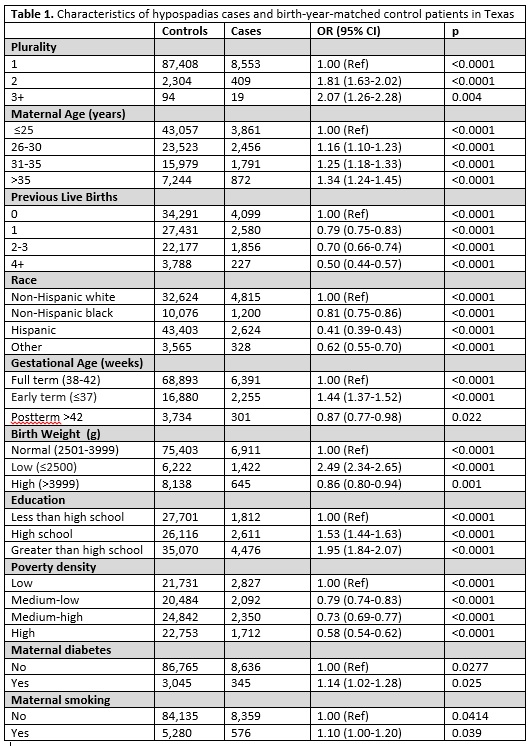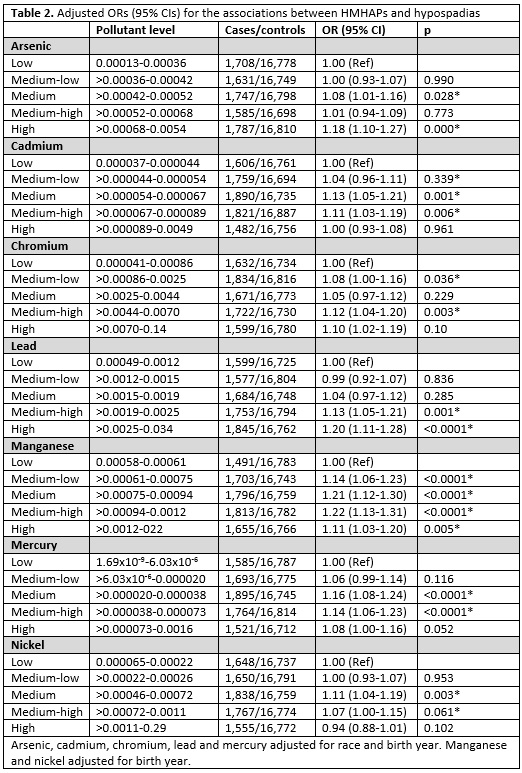Hypospadias Risk is Increased with Maternal Residential Exposure to Heavy Metal Hazardous Air Pollutants
Jeffrey T. White, MD, PhD1, Erin Kovar, BA2, Tiffany M. Chambers, BA3, Kunj R. Sheth, MD1, Erin C. Peckham-Gregory, MPH, PhD3, Abhishek Seth, MD, MS1, Carolina J. Jorgez, PhD4, Philip J. Lupo, MPH, PhD3.
1Baylor College of Medicine / Texas Children's Hospital, Houston, TX, USA, 2Baylor College of Medicine, Houston, TX, USA, 3Section of Hematology-Oncology, Department of Pediatrics, Baylor College of Medicine, Houston, TX, USA, 4Scott Department of Urology, Baylor College of Medicine, Houston, TX, USA.
BACKGROUND: Hypospadias is the most common external male genital malformation. Pollutants which interfere in the normal penile developmental processes may play a role in hypospadias etiology. By combining a nationwide database of hazardous air pollutants with results from the Texas Birth Defects Registry, we were able to assess the spatiotemporal associations of heavy metal hazardous air pollutants (HMHAPs) and hypospadias to test the hypothesis that prenatal exposure to HMHAPs is associated with an increased risk of hypospadias in a subsequently delivered fetus.
METHODS:Data on non-syndromic, isolated hypospadias cases (n=8,981) and control patients delivered in Texas between January 1, 1999 and December 31, 2008 were obtained from the Texas Birth Defects Registry and frequency matched by year of birth using a ratio of ten controls to one case. Estimates of average annual exposure to environmental concentrations of HAPs were obtained from the 2005 U.S. EPA National-Scale Air Toxics Assessment. Exposure levels were categorized based on the 20th, 40th, 60th and 80th percentile cutoffs in controls. Odds ratios and 95% confidence intervals were estimated for each increasing exposure category.
RESULTS: We observed interesting associations between demographic characteristics and hypospadias (Table 1). There was a statistically significant correlation noted between risk for hypospadias and plurality, maternal age, as well as maternal education. A statistically significant inverse correlation was seen between risk for hypospadias and the number of previous live births, gestational age as well as birth weight. Race was significantly protective from hypospadias with the effect of Hispanics being greater than non-Hispanic blacks. Presence of maternal diabetes or smoking was associated with a statistically significantly increased risk for hypospadias.

We observed modest but consistent associations of prenatal HMHAPs exposure with increased risk for hypospadias (Table 2). Only manganese demonstrated significant association for increased risk of hypospadias at all exposure quintiles. Lead showed significant association with hypospadias risk only in the medium-high and high exposure quintiles. Cadmium, mercury and nickel demonstrated a statistically significant bell-shaped association for exposure quintiles with increased risk for hypospadias. Arsenic and chromium demonstrated a significant bivalent association for increased risk of hypospadias: arsenic for the low-medium and high quintiles versus chromium for the medium-low and medium-high quintiles. 
CONCLUSIONS: Using data from one of the world’s largest active surveillance birth defects registries, we found modest but significant associations between hypospadias risk and demographics data as well as HMHAPs exposures . While these retrospective data had only modest effects, the statistical power of the dataset is impressive. These results should be used in counseling for maternal demographic risk factors as well as avoidance of heavy metals and their sources.
Back to 2018 Program




